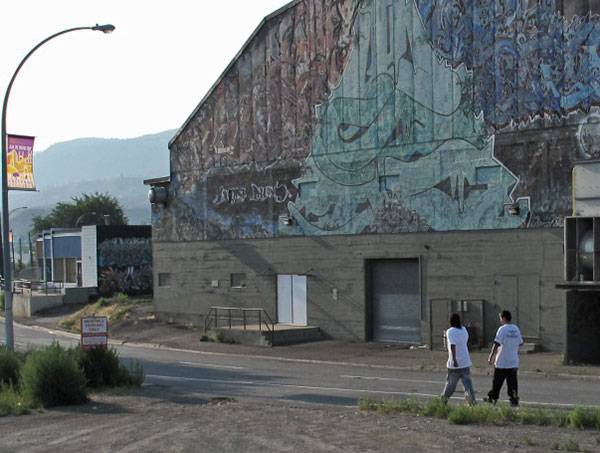The other day I mentioned being inspired by J. G. Ballard’s autobiography, Miracles of Life, in which he stresses that SF is the best way to write about the present. And while I was on the road, I took this dictum to heart (not for the first time), and started looking for things about society that I might transmogrify into gnarly SFnal objective correlatives.

[Awesome giant graffiti mural in Kamloops, Canada.]
Idea #1: living ideas. The internet is still quite new and undigested, some fresh SF ways of treating it could be good. I’ve discussed telepathy and a global mind in Postsingular and Hylozoic. But for this story, let’s do something more literal and less scientific. I think of ideas that crawl around like slugs. And you can stomp on them. And get rid of the parts of yourself that you don’t like. Only then maybe some parasitic mind-virus slugs move in. Like propaganda and ads. Bad ideas.

[Canadian flag over the Banff Springs Hotel.]
Idea #2: dividing bodies. Being in Canada, I got the feeling that the people there weren’t as tense as my fellow citizens of the US. The US is plagued by a lot of unacknowledged conflicts and internal contradictions—elephants-in-the-living-room relating to matters of class, income and race. (Radicals always talk about capitalism’s internal contradictions.)
So then it struck me that it would be interesting if people started literally breaking up into pieces as the result of their contradictory ideas. Like your left arm secedes from your body, and then gets into internal squabbles with the fingers splitting off, and the arm dividing at the elbow. Due to some mysterious upgrade, your arm can live on its own, it can even grow an eye, a mouth, and a simple digestive tract. I can see using this effect for a kicker ending.

[Kamloops, mon amour.]
This week, I worked these ideas into a story called “Bad Ideas,” for Flurb #8, which will be out in mid September. God, it feels good to be writing again. I did have to fight the thought that I was writing this story for, in some sense, nothing—that is, knowing that I’d quixotically plan to put it straight into Flurb without even trying to market it, even though it’s of primo quality. But I also take some pleasure in doing this.
Having been away from writing pretty much continuously for six weeks, I’ve been missing the Muse very much. And yet, I spend so much time every day avoiding Her…

[The next three pictures are at Moraine Lake in Banff National Park.]
With the story done, I’m edging into restarting my work on Jim and the Flims. I look forward to doing something with that “infinity in the middle” idea that I illustrated in that painting, “Topology of the Afterworld.” I’d needed another effect for the last few chapters, so I’ll have a trip to the anomaly at the center, in order to save our Universe. Maybe I call that central spot Helaven, as I’m not sure if it’s Hell or Heaven. It will be interesting to have Jim fall through the divine light of infinity as way of getting back home—although it has to be different from the somewhat similar scene in White Light. More literal.

In Canada, Sylvia and I were boating on a little lake near Jasper, in the Canadian Rockies, a Pyramid Lake, with a big pyramid-like mountain peak right next to it, meadows and bogs and forests flowing gently up to the base of the stone, a lovely place. Our boat had a quiet electric motor, and we were gliding through some water no more than a foot or two deep, with water plants all around—it reminded me of the sea in the Narnia novel, Voyage of the Dawn Treader, which is a place that I always wanted to go. It crossed my mind that this would be a nice effect to have for when Jim is going to Helaven in the center of Flimsy.

Naturally I think of a maelstrom around the central anomaly of Helaven—but, gee, I just had a maelstrom in Hylozoic. So calm shallow water is better. I might focus on the curious growths that appear in the shallow water. Mabye Jim has a realization that he’s inside an electron? The afterworld is everywhere.
More visually, I can see black-gloved cartoon hands on long, skinny, multiply-jointed arms, reaching out from Helaven and grabbing at Jim. Scabs and tattoos on the arms, with the zigzag sequence of elbows folding up like lazy-tongs.
“Right this way, sir.”









August 15th, 2009 at 7:24 am
Hi Rudy,
Strikes me how you write so frankly about your creative process in your blog. Are you not afraid people stole your ideas? Are you not afraid that as you reveal the trick behind the magic of your stories people will enjoy it less? And, finally, are you not afraid that as you write about your story ideas you will feel less energy to write the story itself (afterall, you have told them already…)?
Best Wishes from a great fan of you in Brazil,
Igor
August 15th, 2009 at 9:17 am
Igor, I don’t worry very much about people “stealing my ideas” because (a) pretty much any SF idea we can dream up has in fact already been used somewhere, (b) the “idea” isn’t nearly so crucial to a story as is the implementation, that is, the character development, the dialog, the story arc, and the sense of completion at the end, (c) Many of my idea descriptions are kind of incomprehensible in any case, due to brevity, lack of context and/or rough state. “The mathematician godfather makes you an offer you can’t understand…”
This said, one does feel possessive sometimes. And I’m aware that I’m in some sense living dangerously by posting many of my ideas before I write the story or novel. But the cases when people may have “repurposed” my ideas have in any case happened after my work was published. The point is: if they’re gonna rob you, they’re gonna rob you no matter what.
There are a couple of upsides to writing about my ideas in advance. First of all, the preview blog generates interest in the eventual published work. And secondly, I get feedback from my blog-readers, and often the feedback is useful to me in planning my work.
And, last but not least, blogging about my ideas helps me carry out that important writerly activity of avoiding actual writing while at the same time staying in touch with the material. A lot of the writing process is about getting ready to write.
***
You also mention the proverbial “leaving your game in the locker room” worry. I remember that Hemingway used to write about this. It’s the fear that you talk too much about a story, then maybe you won’t actually write it. Here again, there’s a grain of truth. Particularly if you’re a beginning writer and the people around you are of a discouraging bent, then talking about your ideas can be a crushing experience.
In my case, I do find that sometimes, in fact, it IS enough to describe a story idea without writing the story. But if an idea is meant to be, I keep returning to it and obsessing about it until I write the story. Alternately, I might save the as-yet-unused idea in a list I keep ready for the occasions when I need to come up with a story on relatively short notice.
I do often have the sense that blogging about an idea clarifies it in my mind, and makes me feel more like writing about it. Pitching the idea, telling it, sharing it—these are ways of polishing it. And keep in mind point (b)—just telling an idea really isn’t the same as writing the whole story or novel. I always discover much more when I work out the details at length.
August 20th, 2009 at 1:14 am
“Don’t worry about people stealing your ideas.
If your ideas are any good,
you’ll have to ram them down people’s throats.”
Howard Aiken (designed 1st IBM Computer)